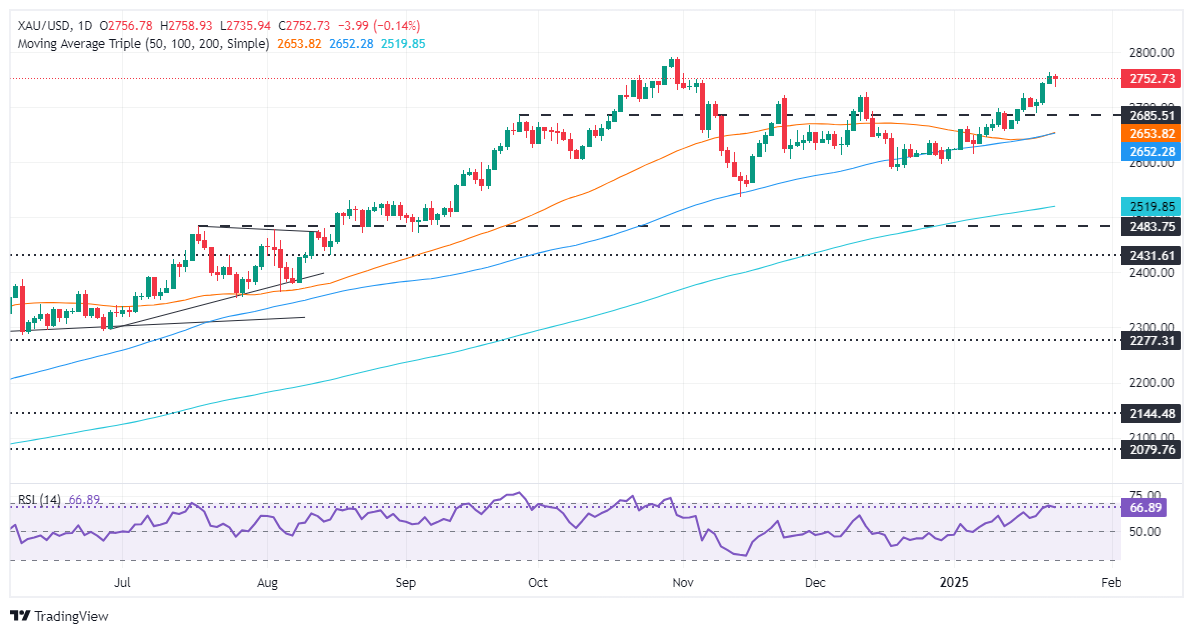Gold price remains subdued amid soft US jobless claims report
- Gold recovers from $2,735 dip as US jobless claims rise from temporary factors.
- US Dollar Index falls slightly, bolstering Gold as markets await major central banks' rate decisions.
- Geopolitical events and central bank actions to drive markets; BoJ to expect hike rates, ECB likely to cut.
Gold's price holds firm after sliding to a daily low of $2,735 amid elevated US Treasury bond yields. Economic data from the United States (US) showed the labor market is cooling, while market participants continued to digest US President Trump’s trade policy rhetoric. The XAU/USD trades at $2,755, virtually unchanged.
Bullion prices are set to finish the week with solid gains despite trimming some of their gains on Thursday.
Data from the US Department of Labor revealed that more Americans applied for jobless benefits during the week ending January 18, which usually would signal a weakening labor market. Nevertheless, the report showed that weather distortions and the fire in Los Angeles are the main reasons for this and will likely be reflected in subsequent releases.
The yellow metal’s last leg up was sponsored by the fall of the Greenback. According to the US Dollar Index (DXY), which measures the performance of the Greenback against a basket of six peers and usually correlates inversely to Gold, tumbled 0.08% to 108.06.
On Friday, the central bank bonanza begins with the Bank of Japan (BoJ) expected to hike rates by 25 basis points (bps). Next week, the Federal Reserve (Fed) and the European Central Bank (ECB) are up next with the former projected to keep rates on hold, while the ECB is foreseen cutting borrowing costs by 25 bps.
This week, the US economic docket will feature S&P Global Flash PMIs, housing data and the final release of University of Michigan (UoM) Consumer Sentiment for January.
Daily digest market movers: Gold price consolidates above $2,750 on modest jobs data
- Gold price rose as real yields remained unchanged on Thursday. Measured by the 10-year Treasury Inflation-Protected Securities (TIPS), yield sits at 2.19%.
- The US 10-year Treasury bond yield is up four bps during the day at 4.637%, putting a lid on Gold’s advance.
- US Initial Jobless Claims for the week ending January 18 increased by 223K, up from 217K in the previous release and above estimates of 220K. The Jobless Claims 4-week average rose from 212.75K to 213.5K for the first time in five months.
- A report by Reuters revealed that US President Trump confirmed that universal tariffs on all imports to the US are also under consideration and will come at a later stage.
- Market participants are pricing in near-even odds that the Fed will cut rates twice by the end of 2025 with the first reduction occurring in June.
XAU/USD technical outlook: Gold price advance pauses, bulls eye $2,790
Gold prices consolidate near $2,750 as traders book profits ahead of the Fed’s decision next week regarding monetary policy. If the Fed keeps rates unchanged, it would be the first time the bank pauses, which would be detrimental for Bullion buyers.
Despite this, a strong uptick on inflation could spark a buying frenzy into the non-yielding metal, pushing prices higher. In that outcome, if XAU/USD surpasses the all-time high (ATH) at $2,790, up next is the $2,800 mark. Once surpassed, key psychological levels would be exposed at $2,850 and $2,900.
On the downside, if bears drag Bullion prices below the $2,750 figure, the 50 and 100-day Simple Moving Averages (SMAs) emerge as support levels, each at $2,651 and $2,640. If surpassed, up next lies the 200-day SMA at $2,515.
Economic Indicator
Initial Jobless Claims
The Initial Jobless Claims released by the US Department of Labor is a measure of the number of people filing first-time claims for state unemployment insurance. A larger-than-expected number indicates weakness in the US labor market, reflects negatively on the US economy, and is negative for the US Dollar (USD). On the other hand, a decreasing number should be taken as bullish for the USD.
Read more.Last release: Thu Jan 23, 2025 13:30
Frequency: Weekly
Actual: 223K
Consensus: 220K
Previous: 217K
Source: US Department of Labor
Every Thursday, the US Department of Labor publishes the number of previous week’s initial claims for unemployment benefits in the US. Since this reading could be highly volatile, investors may pay closer attention to the four-week average. A downtrend is seen as a sign of an improving labour market and could have a positive impact on the USD’s performance against its rivals and vice versa.
Forex News
Keep up with the financial markets, know what's happening and what is affecting the markets with our latest market updates. Analyze market movers, trends and build your trading strategies accordingly.


















